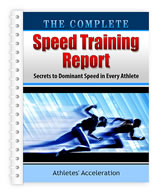Top Speed TrainingTop Speed or Maximum Velocity is another way of saying running at full speed. The point in a race, workout or game that you reach maximum velocity depends on strength levels, experience and running mechanics. However, regardless of where and when you reach full speed, there are some differences in running mechanics and effort when compared to acceleration speed. When running at full speed, you no longer need to try and apply the same level of force to the track as during acceleration. This is a common mistake among inexperienced athletes. Now that you are at full speed, you will be completely upright (perpendicular to the ground) and your body will no longer be leaning at an angle as you were during acceleration. By continuing to try to run faster and faster throughout a run, as though you were still accelerating, you are actually going to have a breakdown in running mechanics. By continuing to try to accelerate while beginning to fatigue, you will only slow yourself down faster because you can not continue to coordinate your movements with accuracy. Instead, you want to relax or ‘float’ during maximum velocity. What this means is that you want to ease back in the amount of effort you are expending while running, but without slowing down and losing any speed. This idea sounds contradictory and like any new skill, it takes some practice to perfect and some top speed drills. While running, you want to continue to step over the opposite knee, but instead of driving the ball of the foot down into the ground, you are just going to tap the foot downward, letting the ground come to you. Continue to drive the elbows down and back at the same speed, but without the same intensity as during the early part of your run. Remember, you are not going to get any faster at this point so energy conservation is important. We know that your brain tells you to keep running harder so that you do not slow down, but you have to fight the urge to do that and run smart. It is the ability to make these types of adjustments that can be the difference in running a fast time, outrunning an opponent or chasing one down to make the play.
Maximum Velocity Running Cues 1. Fly 20s, 30s and 40s: 2. Sprint/Float/Sprint
Click Here to Go Back to the
Related Articles: Speed Training | 4 Most Important Words that Improve Speed | Linear Speed Development | Summer Training for Speed | Summer Training for Speed - Part II | Speed Coach | Speed Coach of the Year | Top Speed Training | Acceleration Speed Development | Goal Setting for Speed Athletes | Speed Training Practice | New Breed of Speed Coach | Acceleration Speed Training | MOST Important part of speed training | Strength Training for Speed and Power Athletes | Conditioning Workouts for Speed Athletes | Speed Training Conditioning
|
|||||
